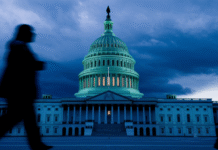The Core Message of the 2024 Campaign
The “America First” slogan, first popularized in the early 20th century and powerfully revived in 2016, once again formed the bedrock of Donald Trump’s 2024 presidential bid. This time, however, the message was less about a new direction and more about a national restoration. The campaign narrative consistently positioned him as the only figure capable of reversing the course set by the Biden administration, framing his return as a necessary correction. This core message was not just a collection of promises but a carefully constructed communication strategy designed to resonate with a specific segment of the electorate.
At the heart of this approach was a potent populist rhetoric. The Trump campaign strategy analysis reveals a deliberate focus on themes of economic nationalism and uncompromising border security. These were not just policy points but emotional touchstones intended to mobilize his core supporters. Every speech and social media post was crafted to create a stark contrast with the Democratic party, presenting his vision as the direct antidote to what his campaign labeled as systemic failures. This created a clear ‘us vs. them’ dynamic that simplified complex issues into a battle for the nation’s soul.
The strategy was to speak directly to the grievances of voters who felt left behind by globalism and cultural shifts. By promising to reclaim lost jobs and restore a perceived past greatness, the campaign tapped into a powerful current of nostalgia and frustration. The messaging was less about intricate policy details and more about a feeling of strength and defiance. This narrative was central to understanding the political appeal of the figure at the center of this movement, as it solidified his image as a fighter for the common person against entrenched interests.
Economic Proposals and Projected Fiscal Impact
The Trump economic platform for 2024 was built on a foundation of aggressive tax cuts and protectionist trade policies. It aimed to stimulate the economy by reducing the tax burden on both corporations and individuals, echoing the principles of his first term while introducing new proposals targeted at specific voter demographics. This economic vision was a cornerstone of his promise to restore American prosperity.
Extending Tax Cuts and Introducing New Relief
A central component of the Trump tax cut proposals was the plan to make the 2017 Tax Cuts and Jobs Act permanent. This move was primarily aimed at benefiting corporations and high-income earners by locking in lower tax rates. Beyond extending existing policies, the campaign introduced new, targeted relief measures designed to appeal to a broader base. One of the most talked about proposals was the elimination of federal income taxes on tips, a direct appeal to millions of workers in the service and hospitality industries. Another significant proposal was to make Social Security benefits exempt from federal taxes for many recipients, a move calculated to win support from middle to upper income seniors who saw it as a way to increase their disposable income.
Analyzing the Fiscal Consequences
While these proposals were popular with their target audiences, they raised significant questions about their long term fiscal impact. Independent analyses painted a concerning picture. According to a projection from the Penn Wharton Budget Model, the combination of proposed tax cuts and spending plans would add trillions to the national deficit over the next decade. The campaign argued that economic growth spurred by the cuts would offset the revenue loss. However, many economists remained skeptical, pointing to the potential for increased consumer costs and inflationary pressures resulting from the proposed tariffs. These tariffs, intended to protect American industries, were seen by critics as a tax on consumers that could negate the benefits of the income tax reductions.
| Policy Proposal | Primary Beneficiaries | Projected 10-Year Fiscal Impact |
|---|---|---|
| Make 2017 Tax Cuts Permanent | Corporations and high-income individuals | Significant increase in national deficit |
| Eliminate Federal Tax on Tips | Service industry workers (e.g., restaurant, hospitality) | Moderate reduction in federal revenue |
| Eliminate Federal Tax on Social Security | Middle-to-upper-income seniors | Substantial reduction in federal revenue |
| Implement Wide-Ranging Tariffs | Domestic industries shielded from foreign competition | Potential for increased consumer prices and inflation |
A Hardline Stance on Immigration and Border Control
Few issues defined the 2024 campaign as starkly as immigration. The Trump immigration plan 2024 was not just a continuation of previous policies but an escalation, promising an aggressive and unprecedented crackdown on both legal and illegal immigration. This hardline stance was strategically designed to energize the Republican base, for whom border security remains a top priority. The proposals were clear, uncompromising, and served as a powerful rallying cry for his supporters.
The plan was built around several key pillars, each representing a significant departure from current and past norms. These proposals were intended to signal a zero tolerance approach to immigration enforcement:
- Initiate the largest domestic deportation operation in U.S. history, targeting millions of undocumented immigrants.
- End birthright citizenship for the children of undocumented immigrants, a move that would challenge the long-standing interpretation of the 14th Amendment.
- Reinstate the “Remain in Mexico” program, requiring asylum seekers to wait outside the U.S. while their cases are processed.
- Continue and expand construction of the wall along the southern border.
These proposals immediately drew intense reactions. Critics raised alarms about the immense logistical, humanitarian, and legal hurdles involved. The idea of a mass deportation operation, for example, brought to light the immense challenge of coordinating federal and local agencies, a process fraught with complexities. Past government efforts have highlighted these difficulties, such as when a nearly $20 million migrant housing contract was scrapped over an empty facility, showcasing the gap between policy goals and operational reality. The debate over these policies exposed the deep societal divisions on immigration, transforming the issue from a policy discussion into a cultural battleground.
Navigating the Complexities of Abortion Policy
In the political landscape reshaped by the overturning of Roe v. Wade, abortion became one of the most delicate issues for Republican candidates. Donald Trump’s official position was to leave the matter to individual states, a stance that acknowledged the issue’s volatility. This approach was a calculated move to sidestep a politically perilous national debate that had proven to be a powerful motivator for Democratic voters. It was a strategy of deliberate ambiguity, aimed at satisfying different factions within the electorate.
This states’ rights advocacy, however, was often paired with a contrasting message. As reported by sources like CBS News, while publicly deferring to states, Trump also signaled an openness to a 15-week federal ban on abortion. This dual approach was a political balancing act. The deference to states was meant to reassure moderate voters and suburban women who were wary of a federal crackdown on abortion access. Simultaneously, the mention of a federal ban was a nod to the social conservatives and evangelical voters who form a crucial part of his base and demand a more aggressive anti-abortion stance.
This strategic ambiguity highlighted the broader struggle within the Republican party on how to address abortion. The friction was visible even on the presidential ticket, with running mate JD Vance holding more staunchly anti-abortion views. This internal tension revealed that even with a stated policy, the issue remained a point of contention. The campaign’s handling of abortion reflected its awareness of how divisive societal issues, including the ongoing debates surrounding transgender rights, require careful messaging to avoid alienating key voter blocs.
The Vision for Governance and Foreign Policy
Beyond specific domestic issues, the campaign outlined a broad governing philosophy for a potential second term centered on deregulation, the expansion of executive authority, and a fundamental re-evaluation of America’s role in the world. The Donald Trump 2024 policies promised a significant dismantling of the existing federal apparatus and a pivot away from decades of established foreign policy consensus. This vision was one of disruption, aimed at reshaping both how America is governed at home and how it interacts with other nations.
A key part of this agenda involved reversing major policies of the Biden administration, particularly those related to climate and the environment. The plan included several specific actions:
- Withdrawing from international climate agreements that the campaign argued were detrimental to the U.S. economy.
- Reversing environmental regulations on emissions and land use to unleash domestic energy production.
- Aggressively promoting fossil fuels, including coal, oil, and natural gas, as central to American energy independence.
- Re-evaluating financial and military commitments to international alliances, demanding that allies pay more for their own defense.
This agenda was coupled with a clear intent to expand the power of the executive branch. Critics raised concerns that this approach could erode institutional norms and checks and balances. In foreign policy, the proposed reassessment of alliances caused apprehension among traditional partners. The questioning of commitments to bodies like NATO signaled a potential shift toward a more isolationist and transactional approach to international relations. The overall vision was one of rapid, decisive change, driven by a belief that existing structures were failing the country.
The Electorate’s Verdict on Trump’s Vision
The 2024 campaign platform, with its bold promises and confrontational style, elicited sharply divided reactions from the American electorate. For his loyal base, the vision of national restoration and an “America First” agenda was met with enthusiastic support. These voters saw the proposals on immigration, taxes, and deregulation as necessary corrections to restore the nation’s strength and sovereignty. The aggressive rhetoric was not a flaw but a feature, signaling a leader willing to fight for their interests.
Conversely, Democrats and a significant portion of independent voters viewed the platform with apprehension. For them, the same policies represented a threat to democratic norms, international stability, and social progress. The hardline immigration plan and the potential for increased national debt were major points of concern. The US election 2024 policy debate became less about nuanced differences and more about two fundamentally opposing visions for the country’s future.
Ultimately, the election results provided a verdict on this strategic choice. The campaign’s focus on mobilizing its base through controversial policies proved highly effective in some areas but alienated crucial swing voters in others. As we look back from 2025, it is clear that the political fault lines exposed and deepened by the campaign continue to define American politics. To stay informed on these ongoing developments, you can follow the latest news and analysis on our platform.







